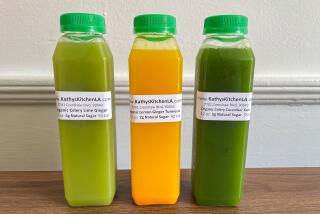The Seeds of Youth
- Share via
Up the street from where I lived with my mother and father, there was a school for children with cerebral palsy. I went there once to read a storybook to the students, who sat in their wheelchairs and listened to me in silence.
Otherwise, my only visits to the school were illegal. My friend Yolanda and I would sneak just inside the parking lot, where there were guava bushes. Using a knife to cut open the fruit and a spoon to scoop out the pulp, we’d crouch between parked cars and eat small pineapple guavas until our throats burned.
Then the school closed down, the students sent elsewhere. The gate was chained shut, but not so tightly that a couple of skinny pre-adolescent girls couldn’t squeeze through for a guava gorging.
Soon, we grew bold and set out exploring. It was a beautiful old establishment, originally a preventorium, where children were sent to be quarantined from their tubercular parents.
Built on the lip of an arroyo, building and grounds were designed like a California mission: low, stuccoed buildings with red-tiled roofs, extensive grounds with flower gardens, grape arbors, fruit trees.
Behind the buildings was a grassy playground with swings, teeter-totters and a merry-go-round, which we made free use of. In the front of the buildings were gardens. If you took a path, any path, you would eventually find yourself on a lane lined in tall, bright-green bushes that led to a small swept dirt courtyard in the center of the property. In the middle of the courtyard was a round, ancient-looking fountain, and around the fountain, simple concrete benches.
The slim, bright-green leaves soaked up sunlight. Overhead, the sky was a deep, severe blue. In the early summer, the bushes bloomed with crinkled flowers, red-orange like my mother’s lipstick. Yolanda and I would lie on the cool concrete benches by the fountain and tell each other stories.
Soon enough, however, the vacated school acquired a caretaker. We discovered this when he chased us off the swings one day. We ran screaming from the playground, which must have disturbed him: The next time we were caught, he blocked our exit.
“Does your mother know where you are?” he asked.
“No,” we admitted. My mother was still at work. She thought I was home or out bike-riding.
That night the caretaker and his wife showed up at my house. They wanted to introduce themselves to the neighbors, and in particular to my parents, since I was over at the school all the time. The caretaker and his wife caused something of a sensation in the family: He had long gray hair in curls and said he was a sculptor.
His wife was very young, 19 or 20, and Swedish; she spoke with an accent, and her long blond braid was fat as her arm. I worried that their visit would get me into trouble, but somehow the upshot was that I could go over to the school any time I liked, if I told my mother first.
As the year progressed, I spent a lot of time in the playground and by the fountain, mostly by myself. Yolanda, three years older, had entered junior high school and suffered an abrupt loss of interest in swing sets and make-believe. I rarely saw the caretaker, although once his wife gave me juice and a cookie in her kitchen.
In the fall, the bright bushes around the fountain came out with countless red pomegranates. They hung in the bushes like Christmas balls. I loved them, their leathery red skins, the shocking beauty of their sparkling, blood-red seeds, their single crenelated, hairy nostrils. There must have been hundreds. I was only 9, but the need to make use of such bounty was keen.
I decided to make grenadine.
I knew about grenadine. It was the active ingredient in Shirley Temples, the one item in my parents’ liquor cabinet of which we kids could partake.
The caretaker’s wife gave me a paper bag. I picked until I got tired and lugged home maybe two dozen ripe pomegranates.
I cracked open a few in the kitchen sink and pulled garnet seeds from pale, honeycombed membranes. This process was time-consuming. Nobody told me to work underwater, in a pan or basin, where the splatter could be contained and diluted and the seeds would sink and all the ivory membrane would float to the surface.
I deliberated how to extract the juice. I tried mashing the seeds with a wooden spoon in a bowl. No luck. I strewed seeds on the cutting board, found a short length of board and a hammer. I covered the seeds with the short board, hit the board with the hammer and pushed the juice into a measuring cup.
After a very long time, I had about a quarter cup of purple juice, and everything--my hands, my clothes, the boards and counterwas stained a stubborn purple. That’s when my father walked in.
“I’m making grenadine,” I told him. “But I have a problem. This juice is purple. Grenadine is red.”
My father said that commercial grenadine had food coloring in it. He also said that the grenadine factory probably had a press to extract the juice by the gallon and that the gallons of juice would then be cooked down with sugar.
He fetched the bottle of grenadine from the liquor cabinet. On the label was a sexy, dark-skinned woman in tropical dress. The primary ingredient listed was corn syrup--where would I get that? And if there were pomegranate juice in this grenadine, it was hidden in the phrase “natural and artificial flavors.”
I gazed bleakly at the sink full of pomegranates and all the purple spatters. My father suggested that since my mom would be home in a few minutes, I might want to clear the area. I put the whole pomegranates in the bag. I didn’t know what to do with the quarter cup of tart, bitter liquid that tasted a lot like the cutting board, so I put some sugar in it and gave it to my father. He drank it right down. “Tastes just like grenadine,” he said.
I found pomegranates in my lunch box for weeks.
Not long after the grenadine experiment, I was in bed, lights out, when there was a frantic knocking at our front door. I heard my parents talking and a woman sobbing. I heard my father call the police. The caretaker, it seemed, had gotten drunk and beaten his young wife. She had come to us for help.
After that, I was forbidden to go to the vacant school. We heard that the caretaker’s wife had left him, then come back, then left him again. I still slipped over to the school from time to time, but my solitary playing there now had a darker edge. Whenever I spotted the caretaker’s gray head out among the rose bushes or over by the tool shed, I ran for home.
Then the caretaker was gone for good, and the place became a shambles. It was winter, and the pomegranate bushes, dormant, were a thicket of dead branches, hung with a few desiccated husks burst open, withering, their interiors crimson-black.
Some wild boys vandalized the school, broke windows and knocked over birdbaths. A new gate, one impossible to slip through, was put in place. Barbed wire was scrolled atop the fences. Soon enough, I too was in junior high, and not so interested in teeter-totters or day-dreaming--or in grenadine.
In English class, I read the myth of Persephone, who wandered off from her mother, Demeter, and was carried away by the King of the Underworld. Demeter, the goddess of grains, ranged over the world looking for her daughter, despondent, neglecting her job. All the living plants shriveled and died.
Then Persephone was found living in the underworld. It was said she could go home--provided she hadn’t eaten anything.
The problem was, she’d eaten a few pomegranate seeds. Some accounts said three, others six. A compromise was reached: She had to stay with her new husband one month of the year for each seed eaten; the rest of the time she could roam the world with her mother.
In my imagination, the myth took place at the abandoned school, my own source of pomegranates. The caretaker was the prince of darkness, his young wife some heartbroken mother’s missing daughter. I identified myself with Persephone, who, like me, also had a working mother and thus could wander off a little too far, to the very end of the apron strings and farther, drift distractedly into the realms of danger without really knowing when that border was crossed.
It made perfect sense to me that a child taken from home would eat a pomegranate: Without mothers, what else do children eat but things they pluck from bushes and trees?
And I understood why Persephone ate only a few seeds--three, six. After the initial rush of intense, tart flavor when the red seed bursts, you’re left with tasteless, inedible roughage--and a thirsty, puckered mouth.
POMEGRANATE SYRUP
1 quart pomegranate juice (juice from 12 large pomegranates)
1 tablespoon lemon juice
3/4 cup sugar
Place pomegranate juice in saucepan over high heat and reduce by half, about 20 minutes. Reduce to simmer and stir in lemon juice and sugar. Stir until dissolved. Will keep two weeks in refrigerator. For longer storage, pour it into clean, sterilized 1-pint jar, seal with new lid and metal ring and process for 5 minutes in hot water bath. Remove, cool and check seal. Keep in cool place.
Makes 1 pint.
Each 1-tablespoon serving contains about:
57 calories; 2 mg sodium; 0 cholesterol; 0 fat; 15 grams carbohydrates; 1 gram protein; 0.12 gram fiber.
More to Read
Sign up for Essential California
The most important California stories and recommendations in your inbox every morning.
You may occasionally receive promotional content from the Los Angeles Times.













